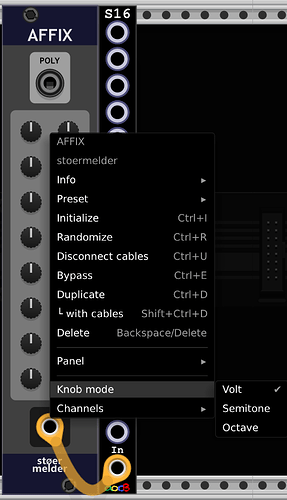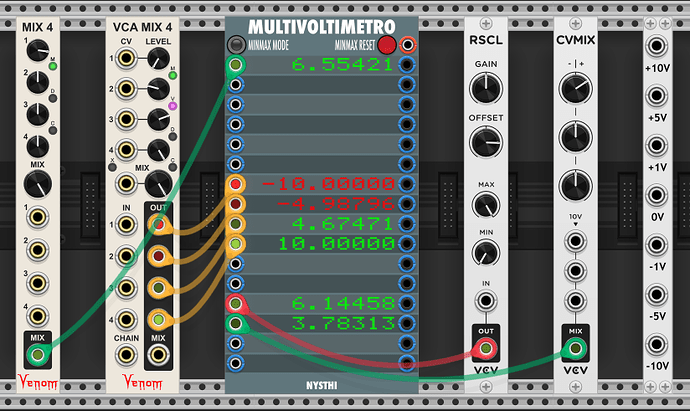d̶r̵o̶n̶̮͚̓̒͘e̶̬̦̞̅n̸͓̬̬̼̒̉͝o̵̧̨̤̞̹͂̏͊͌̈́i̴͉̿̐̐̓͝s̴̝͇͔͓̒̔́́͑͜ȅ̷̹̥͓̹͚̹̱̦̍ͅḑ̴̡̢͙͉̮̺̲̘̙̯̖̙͂̓į̴̻̭͉͈͙̖̬̻͉͈͌̌̈̇̒͑̀̽͂͊́̂̈́̐s̸̡̨̥͓̃̈́̉̄̓͗̒t̸̡̧̥͔͉͉͍̭͖̮̖̺̊̊͊̂̔̕͜o̷̟̱͙͆̇͋͜͜ŕ̵̨̧͔͓̤̼̉̓̈́̇̊̔̐͋t̶̬̠̻̖̓̍ĩ̷̠̙̤͋͌̕o̴͙͙̰̓n̵̮̣̣͝. The only modulation is on the Symmetry of Repelzen’s Re-Fold but there are some spots where the thing keeps going:)
Beautiful, very Vangelisian! Need I say more.
I worked on the patch a bit more, for some changes over time and the music suddenly faded out and yes, I spent at least 3 Minutes with Mixmaster’s Main on mute, listening to the video that started playing when I looked up your comment in here ![]()
Not the first one of us to do that, mute is a beggar to spot sometimes. When you got a lot going on in a patch. Is the patch available to play around with btw?
Uses Valhalla Delay, Tape Mello-Fi and Choose-Your-Own-Sample!
Thank you. Much appreciated.
That’s fantastic, really tasteful and relaxing.
Money well spent.
Patch notes for the curious:
Pam’s tracks 3 and 4 just cycle through a triangle wave, on a relaxed beat division, but sample+hold themselves on triggers received from the euclidian sequences with different lengths played by track 1 and 2, thus generating rhythmically stepped outputs: v/Oct for the two Resonators. (Pam’s has its own Quantizers, but putting in custom scales is comparatively cumbersome and I like Grande for its Trigger output on note change). Pam’s track 5 is constant BPM, used to clock the MFXs (two different delays) and on a /16 division sends a random value back to modulate the rise/fall of track 4’s triangle-shape to alter the amount of notes stepping up VS stepping down.
(oh, and Wake and Nap: track 1 goes silent once in three loops, track 2 twice in four.)
A few modulations via Midi and the DBiz utility bottom left: the trigger density of the two euclidian sequences on track 1&2 and the /x of the beat division of track 3, effectively expanding or contracting the triangle wave, affecting the spread of note events.
Also, regarding my use of that dBiz module bottom left: is it just me, or is there a dearth of knobby, preferably slim, fixed voltage modules!?
Really nice tune Urs, like it a lot!
Regarding:
For simple use, wanting more than a couple of voltages, it’s hard to beat 8vert:
If you go outside “knobby” or into polyphonic (which needs mergers/splitters) there’s a lot of options. I find this one pretty handy:
Thanks, this was a fun one. Or is.
I always have a Vult Knobs out when I’m patching for manual values but I need mooarr! 8Vert, perfect! Didn’t quite think of this one, hm.
Yeah, that’s slim! I just hate those micro-knobs…
Oh, that is slim. (And I see 1 1/2 library pages worth of docB modules I don’t have yet)
VCV RSCL and CV MIX can provide a single constant value if not given any input. CV MIX will sum all three knobs, so that has a +/- 30 V range.
Alikins Reference Voltages is the ultimate in convenience for common integral values.
Venom MIX 4 was inspired by VCV CV MIX. It can also provide a single CV value, except there are 4 knobs, and the Mix gain can go as high as x10, so the range is +/- 400 V. Note the Mode (small M button) must be in a bipolar mode (green, light blue, or dark blue) to get voltages without input. If in unipolar mode (pink or purple), then the knobs only attenuate/amplify the input.
Venom VCA MIX 4 combines features of MIX 4 plus VCV VCA MIX. So it can provide 4 CV values. If you really want you could get a fifth value using the Mix gain against the sum of all 4 values.
A couple nice features of the Venom modules
- Each knob has options within its context menu to lock the knob. Once locked, the value cannot be changed until it is unlocked. There are also module context menu options to lock/unlock all parameters.
- Each knob context menu also has an option to set the default to the current value. So you might have a patch where you typically want to use some default value. Set that as the default. Then you can change the value during performance and quickly get back to your custom default by double clicking. Once you have defined a custom default, an additional option appears to restore the factory default.

Now that you have brought up this topic, I think I will create a 3 hp module with 5 knobs at the top and 5 outputs at the bottom for constant voltages. I will likely include range and possibly unit options.
If you want constant values for pitch, then you have at least two good options.
Bogaudio Reftone gives very convenient access to any pitch via the C4 = 0V standard
ML Modules Constants provides convenient access to commonly used intervals using the V/Oct standard

I often find myself wanting a) to really explore what a modulation does, b) a bridge for midi control or c) make a pretty colour in Nysthi’s Etchasketchoscope ![]() , so…
, so…
![]()
I use 8-vert for everything. Probably my most used module.
Pulled the old devices out. Should do this so. much. more. often.
Keystep, Microfreak, Makenoise Strega and Mr. VCV on the reverbdelay.
… turns out, driving a piece with 16 LFOs can be pretty interesting even if they never line up again - some LFOs run at the same frequency so there are chords at a constant pace - or for that matter, the repetition of the lowest resp. highest note - around which everything else flows.
(Noire, Resonator, Clouds)









